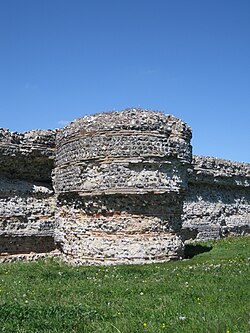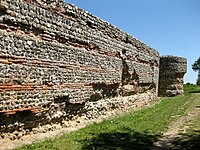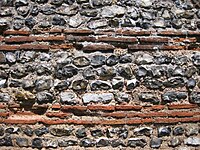Burgh Castle Roman Fort: Difference between revisions
Created page with "{{Infobox castle |name=Burgh Castle Roman Fort |county=Suffolk |picture=Gariannonum Burgh Castle east wall turret detail.jpg |picture caption=A turret on the wall of Burgh Cas..." |
No edit summary |
||
| (One intermediate revision by one other user not shown) | |||
| Line 29: | Line 29: | ||
===Roman Fort=== | ===Roman Fort=== | ||
[[File:Gariannonum Burgh Castle south wall well preserved.jpg|left|thumb|200px|The well preserved southern walls]] | [[File:Gariannonum Burgh Castle south wall well preserved.jpg|left|thumb|200px|The well preserved southern walls]] | ||
The fort is roughly rectangular measuring (internally) approximately | The fort is roughly rectangular measuring (internally) approximately 660 feet by 330 feet. The walls on the north, east, and much of the south side are largely intact, standing at a height of approximately 15 feet and measuring up to ten feet thick at the base. They have a core of mortared flint rubble and an external and internal facing of prepared flint and red tile or brick in alternating bands. Against the outer face of the walls there are six solid bastions of pear-shaped plan spaced symmetrically, two on the south wall, one each at the north east and south east angles, one slipped from position on the north wall, and one below the south wall where it has fallen. The west wall has at some time in the distant past collapsed down the underlying hillside and into what was once an estuary but is now a marsh, and nothing of it is now visible. | ||
The fort would have stood on an estuary open to the sea. [[Breydon Water]] is all that is left of this estuary.<ref name=EHP /> | The fort would have stood on an estuary open to the sea. [[Breydon Water]] is all that is left of this estuary.<ref name=EHP /> | ||
| Line 36: | Line 36: | ||
===Monastic settlement=== | ===Monastic settlement=== | ||
Burgh Castle has been suggested as the site of | Burgh Castle has been suggested as the site of ''Cnobheresburg'', the unknown place (a castrum or fort) in East Anglia, where in about 630 the first Irish monastery in southern England was founded by Saint Fursey as part of the Hiberno-Scottish mission described by Bede. Historians find many arguments against this location, but are unable to agree on a better one. | ||
The fort site was excavated by the archaeologist Charles Green between 1958 and 1961, and apparently revealed the remains of a timber monastic church, in the southwest corner of the fort, with a Christian cemetery just to the north of it, which contained some 144 interments as well as pits containing re-interred bones. A cluster of oval huts towards the north-east angle of the fort may be interpreted as cells or workshops. Coins and 'Ipswich ware' carry the occupation well into the 8th and possibly 9th century. However a detailed report by Stephen Johnson of Norfolk Museums Service in 1983 (''East Anglian Archaeology 20'') concluded that there was no conclusive evidence for any monastic settlement in Burgh Castle itself.<ref name=EHP>{{pastscape|133757|Burgh Castle}}</ref> | The fort site was excavated by the archaeologist Charles Green between 1958 and 1961, and apparently revealed the remains of a timber monastic church, in the southwest corner of the fort, with a Christian cemetery just to the north of it, which contained some 144 interments as well as pits containing re-interred bones. A cluster of oval huts towards the north-east angle of the fort may be interpreted as cells or workshops. Coins and 'Ipswich ware' carry the occupation well into the 8th and possibly 9th century. However a detailed report by Stephen Johnson of Norfolk Museums Service in 1983 (''East Anglian Archaeology 20'') concluded that there was no conclusive evidence for any monastic settlement in Burgh Castle itself.<ref name=EHP>{{pastscape|133757|Burgh Castle}}</ref> | ||
| Line 47: | Line 47: | ||
The fort lies close to the mediæval church of St Peter and St Paul, which incorporates in its fabric Roman brick, presumably taken from the fort site. | The fort lies close to the mediæval church of St Peter and St Paul, which incorporates in its fabric Roman brick, presumably taken from the fort site. | ||
In the 17th century, Sir Henry Spelman recorded a tradition that the fort had been occupied by Jews, and reported the name of a track leading away from it as "Jews' Way". (A surviving fragment of the route, in the adjacent parish of [[Bradwell, | In the 17th century, Sir Henry Spelman recorded a tradition that the fort had been occupied by Jews, and reported the name of a track leading away from it as "Jews' Way". (A surviving fragment of the route, in the adjacent parish of [[Bradwell, Suffolk|Bradwell]], is still named "Jews Lane".) This is likely to reflect a popular sense of the site having been the home of an ancient but enigmatic people, and perhaps its use as a quarry for building materials.<ref>{{Cite journal |last=Harris |first=Oliver |title=Jews, jurats and the Jewry Wall: a name in context |journal=Transactions of the Leicestershire Archaeological and Historical Society |volume=82 |year=2008 |pages=113–33 (122)}}</ref> | ||
==Location== | ==Location== | ||
The site is located to the west of the village and civil parish of [[Burgh Castle | The site is located to the west of the village and civil parish of [[Burgh Castle]]. It is located on the eastern bank of the southernmost part of [[Breydon Water]], formed at the mouths of the Rivers [[River Ant|Ant]], [[River Bure|Bure]], [[River Yare|Yare]], and [[River Waveney|Waveney]]. Today however it is separated from the estuary by mudflats. | ||
The Roman Shore Fort site of [[Caister Roman Fort|Caister-on-Sea]] lies a few miles to the | The Roman Shore Fort site of [[Caister Roman Fort|Caister-on-Sea]] lies a few miles to the north-east. | ||
The site is owned by the Norfolk Archaeological Trust, with the walls in the care of English Heritage. The site is freely open to the public.<ref name=EH>{{EH link}}</ref> | The site is owned by the Norfolk Archaeological Trust, with the walls in the care of English Heritage. The site is freely open to the public.<ref name=EH>{{EH link}}</ref> | ||
Latest revision as of 13:22, 10 August 2018
| Burgh Castle Roman Fort | |
|
Suffolk | |
|---|---|
 A turret on the wall of Burgh Castle | |
| Type: | Saxon Shore fort |
| Location | |
| Grid reference: | TG474045 |
| Location: | 52°34’57"N, 1°39’5"E |
| History | |
| Information | |
| Condition: | Fair for its age |
| Owned by: | English Heritage |
| Website: | Burgh Castle |
Burgh Castle in the marshes of Suffolk is the site of a Roman shore fort built around the 3rd century AD. It was part of the system known as the Saxon Shore, a string of forts maintained as a defence against Saxon raids on the coatss and rivers of southern Britain.
Burgh Castle Roman Fort is located on the summit of ground sloping steeply towards the estuary of the River Waveney, in the north-east of Suffolk, amongst the Broads and just above the opening of Breydon Water.
This fort was possibly known as Gariannonum, although the single record that describes it as such may also mean the Roman site at Caister-on-Sea. Between the mid-7th and 9th centuries the site was possibly occupied by a monastic settlement, and in the 11th and 12th centuries a Norman motte and bailey castle existed on the site.[1]
Names
In Roman times there was in the area a fort known as Gariannonum, a name that appears in a single source; the Notitia Dignitatum, a Roman Army “order of battle” from about AD 400. It was once accepted that Garionnonum was Bugh Castle, but this identification is now open to doubt as it may refer to the fort at Caistor-on-Sea.[1]
Today's name, "Burgh", is from the Old English word burh which originally meant "fortress".
Description
Roman Fort

The fort is roughly rectangular measuring (internally) approximately 660 feet by 330 feet. The walls on the north, east, and much of the south side are largely intact, standing at a height of approximately 15 feet and measuring up to ten feet thick at the base. They have a core of mortared flint rubble and an external and internal facing of prepared flint and red tile or brick in alternating bands. Against the outer face of the walls there are six solid bastions of pear-shaped plan spaced symmetrically, two on the south wall, one each at the north east and south east angles, one slipped from position on the north wall, and one below the south wall where it has fallen. The west wall has at some time in the distant past collapsed down the underlying hillside and into what was once an estuary but is now a marsh, and nothing of it is now visible.
The fort would have stood on an estuary open to the sea. Breydon Water is all that is left of this estuary.[1]
Coin and pottery evidence on the site indicates that the occupation of the fort dates from the mid-3rd century AD, with Roman occupation continuing up to the early 5th century AD when the integration of Roman and Saxon traditions appear.[1]
Monastic settlement
Burgh Castle has been suggested as the site of Cnobheresburg, the unknown place (a castrum or fort) in East Anglia, where in about 630 the first Irish monastery in southern England was founded by Saint Fursey as part of the Hiberno-Scottish mission described by Bede. Historians find many arguments against this location, but are unable to agree on a better one.
The fort site was excavated by the archaeologist Charles Green between 1958 and 1961, and apparently revealed the remains of a timber monastic church, in the southwest corner of the fort, with a Christian cemetery just to the north of it, which contained some 144 interments as well as pits containing re-interred bones. A cluster of oval huts towards the north-east angle of the fort may be interpreted as cells or workshops. Coins and 'Ipswich ware' carry the occupation well into the 8th and possibly 9th century. However a detailed report by Stephen Johnson of Norfolk Museums Service in 1983 (East Anglian Archaeology 20) concluded that there was no conclusive evidence for any monastic settlement in Burgh Castle itself.[1]
Norman Castle

In the 11th and 12th centuries a motte was constructed in the south-west corner, using the Roman fort as a bailey. The motte was partly removed in around 1770, in 1839 it was completely levelled. The ditch was in-filled in the same year. Archaeological excavations identified a timber tower on the motte, with the bailey, of the castle located to the northeast of the motte.[1]
Re-use of materials
The fort lies close to the mediæval church of St Peter and St Paul, which incorporates in its fabric Roman brick, presumably taken from the fort site.
In the 17th century, Sir Henry Spelman recorded a tradition that the fort had been occupied by Jews, and reported the name of a track leading away from it as "Jews' Way". (A surviving fragment of the route, in the adjacent parish of Bradwell, is still named "Jews Lane".) This is likely to reflect a popular sense of the site having been the home of an ancient but enigmatic people, and perhaps its use as a quarry for building materials.[2]
Location
The site is located to the west of the village and civil parish of Burgh Castle. It is located on the eastern bank of the southernmost part of Breydon Water, formed at the mouths of the Rivers Ant, Bure, Yare, and Waveney. Today however it is separated from the estuary by mudflats.
The Roman Shore Fort site of Caister-on-Sea lies a few miles to the north-east.
The site is owned by the Norfolk Archaeological Trust, with the walls in the care of English Heritage. The site is freely open to the public.[3]
Fiction
Burgh Castle is the Roman fort featured in the short story Interloper's Folly by S.A Carr.
Outside links
| ("Wikimedia Commons" has material about Burgh Castle Roman Fort) |
- National Monuments Record: No. 133757 – Burgh Castle
- National Heritage List 1013094: Burgh Castle
- Burgh Castle, Norfolk Archaeological Trust
- GARIANNVM, Burgh Castle, Norfolk on 'Roman Britain'
References
- ↑ 1.0 1.1 1.2 1.3 1.4 1.5 National Monuments Record: No. 133757 – Burgh Castle
- ↑ Harris, Oliver (2008). "Jews, jurats and the Jewry Wall: a name in context". Transactions of the Leicestershire Archaeological and Historical Society 82: 113–33 (122).
- ↑ Burgh Castle Roman Fort
| Saxon Shore forts |
|---|
|
Branodunum • Gariannonum (Burgh Castle • Caister) • Walton Castle • Othona • Regulbium • Rutupiae • Portus Lemanis • Portus Dubris • Anderitum • Portus Adurni |

